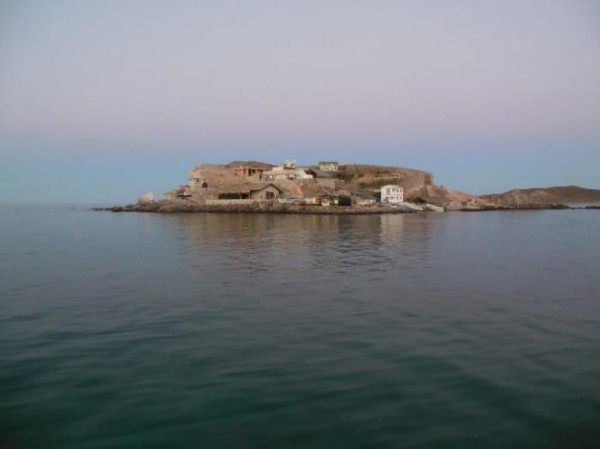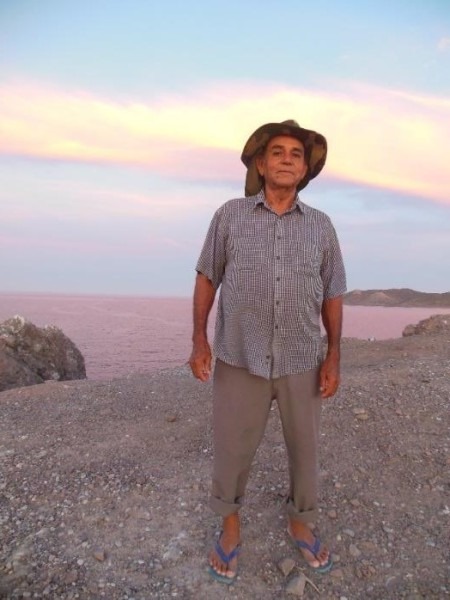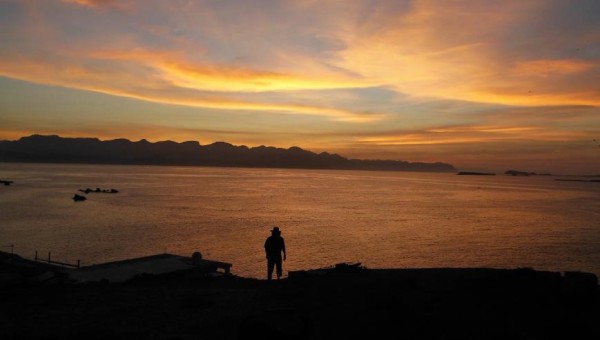“For a fisherman, every day is an adventure and there is nothing more rewarding than to feel the weight on the net and know that you have caught something big.”–Pablo Cuevas, El Pardito Family
Those were the words of Pablo Cuevas, a fisherman from the Gulf of California, while he was remembering good fishing days in the sea. His eyes reflect a sense of truly belonging and gratitude to the ocean that has sustained his life for decades.

Location of El Pardito shown in red, take a closer look
His home, an island named El Pardito, is almost 45 nautical miles northeast of the coastal city of La Paz, in the Mexican state of Baja California Sur. The history of the Cuevas family dates back in the early 20th century when Juan Cuevas, a fisherman native to the state of Sinaloa and Pablo’s grandfather, traveled to the Gulf pursuing his dream of being involved in shark fishing because the liver trade had great value at the time. He decided to settle on this tiny island (less than an hectare by area) because of the great abundance of sharks, turtles, mackerels and rays. For years, the income of the family was based on shark and loggerhead turtle catch and the work was so plentiful that Juan Cuevas ended up with a total of nine children and together with his wife Paula built the fishing village of El Pardito.

Life on the island is difficult. It is not the type of island that we normally imagine, with luxuriant vegetation and plenty of fruits to survive. El Pardito is a desert island, with almost no vegetation except for one or two cacti, no fresh water and where all the supplies come from the peninsula. In early times, it was even worse because residents had to paddle to go to La Paz on a trip that took them around 24 hours to complete. They could spend weeks or even months without going back to the mainland, so they needed to have enough supplies to survive. According to Paula, Juan’s wife and the first woman that lived there, “One get[s] used to it” (Jordán, 1995). She spent a year without leaving the island while Juan went every 8 to 10 days to the closest town on the mainland, El Portugues, to fill up the water barrels on his boat.
Children on the island were a key element for the development of this fishing village; boys became apprentices and learned about sea currents, fishing techniques, animals and weather, and girls were taught skills to clean and salt fish. As a family, the Cuevas worked together and shared the catch and sales. For generations, they developed a strong connection to the ocean, they knew the natural history of the animals, how they moved and where they went. The ocean was full of signals and they knew how to read them.
“We both must catch fish to live [speaking to a sea lion]. May there always be enough fish for us all. But I wish you wouldn’t rip our nets. It takes so long to mend the holes”. Gilberto Cuevas, grandson of Juan at the age of 10 (Dixon and Dixon, 1979).
The first three generations of the family found in El Pardito the best place to live as a fisherman. However, with the increasing fish demand from the mainland, more fishermen arrived to the area and the family experienced a decrease in species abundance and increased illegal fishing activities. Nowadays, to capture sharks they travel long distances or even go to the Pacific side of Baja California.

“We were in the middle of the Pacific ocean, with our small boat and trying not to sleep. It was the scariest night of our lives because we felt so small in that huge ocean, and we had to be aware to avoid big ships or the entanglement of whales.”–Felipe Cuevas, Juan’s great grandson.
They also catch other species which have less commercial value and some of the youngest members of the family do additional activities on the Peninsula related to tourism and music. They are concerned about their future as fishermen; it’s part of their cultural values and they don’t want to lose it.
The astonishing biodiversity of the Gulf of California has been threatened since industrialized fishing was established in the late 19th century. In the early years of the 20th century, by the time Juan Cuevas arrived to El Pardito, some records indicate that a mere two ships hunted more than 800 blue whales in a period of 5 years! It’s impossible not to think, “What is the amount of prey needed to maintain such an abundance of whales and other large species like sea turtles and sharks?”
Fortunately, this region still maintains major concentrations of biodiversity and can provide us with a valuable perspective on what once were complex marine communities. Considered by the explorer Jacques-Yves Cousteau to be the world’s aquarium, the Gulf of California is one of the most biodiverse seas in the world. Its waters harbor more than 2,000 species of mollusks like calamari, octopus and snails; more than 1,000 species of crustaceans such as shrimps and lobster; 36 marine mammals like the vaquita, which is the most endangered marine mammal of the world living only in the upper Gulf; five of the seven species of sea turtles; and many seabirds that have their breeding sites here. More than 900 species of fish have been described and 10 percent of them are endemic to this region, which means that they are not found in any other part of the world.
In an attempt to reestablish the abundance and diversity of marine life, this family and other neighbor villages in the Peninsula have worked with the Mexican non-profit Niparajá to establish a network of 11 Locally Managed Marine Areas that protect a total area of 1,507 hectares. Also, they still use artisanal fishing lines and hooks to have as little of an impact as possible on the environment. They are also involved in the conservation and monitoring of sea turtle populations with the local Mexican non-profit Grupo Tortuguero.

Nearly 100 years have passed since Juan arrived and things have changed substantially for his family, especially because the abundance of species has decreased in the last decades and large species are scarce. This trend on population depletion is particularly difficult to recognize when there isn’t a reference state, or baseline, for the biodiversity that once inhabited the oceans. However, among all the people involved in their exploitation, local fishermen are the ones who have seen changes on the marine biodiversity and abundance through time. Specifically, I am referring to those that have engaged in this activity for generations and that through orally-transmitted knowledge have identified which species are vanishing. The Cuevas family is an example of this.
This family, as with many other fishermen families, is committed to conserving the ocean whose bounty they rely on. The knowledge they have of the ocean is extremely valuable and their contribution in conservation efforts in the Gulf of California is a key element for the success of everyone involved.
All the ecosystems in our planet have sustained life over millions of years. We have evolved in such a prolific way that our activities are changing the course of evolution on our planet. From rainforests to oceans, we have overexploited and modified ecosystems to produce our food, make way for our cities, and meet our demands at a high cost: the extinction of populations and entire species.
As part of this living Planet, it is our duty to reverse our impact and find better ways to develop our activities; this if we really want to keep the diversity of life as we know it.
Lourdes Martínez Estévez is a biologist from Mexico currently pursuing a PhD at UC Santa Cruz researching the conservation of endangered marine species. Additional credit and thanks to Aleszu Bajak whose feedback was used to improve the manuscript.
More information:
Dixon, S. and P. Dixon. 1979. Children, Families and the Sea: Gilberto. Cypress. Glendale, California.
Jordán, F. 1995. Mar Roxo de Cortés: Biografía de un Golfo. CONACULTA. Universidad Autónoma de Baja California. Baja California, México.
Leslie, H., Basurto, X., Nenadovic, M., Sievanen, L., Cavanaugh, K., Cota-Nieto, J., Erisman, B., Finkbeiner, E., Hinojosa-Arango, G., Moreno-Báez, M., Nagavarapu, S., Reddy, S., Sánchez-Rodríguez, A., Siegel, K., Ulibarria-Valenzuela, J., Hudson Weaver, A. and O. Aburto-Oropeza. 2015. Operationalizing the social-ecological systems framework to assess sustainability. PNAS, 112 (19) 5979-5984; published ahead of print April 27, 2015,doi:10.1073/pnas.1414640112
Sociedad de Historia Natural Niparajá
MAHB-UTS Blogs are a joint venture between the University of Technology Sydney and the Millennium Alliance for Humanity and the Biosphere. Questions should be directed to joan@mahbonline.org
MAHB Blog: https://mahb.stanford.edu/blog/people-from-the-ocean/
The views and opinions expressed through the MAHB Website are those of the contributing authors and do not necessarily reflect an official position of the MAHB. The MAHB aims to share a range of perspectives and welcomes the discussions that they prompt.
